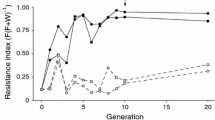Abstract
We examined the short-term effects of genetic architecture on the response to correlational selection in the pitcher-plant mosquito, Wyeomyia smithii. Previously, a positive phenotypic and genetic correlation between development time and propensity to diapause had been identified. Correlational selection consisted of all four combinations of (1) fast and slow development time and (2) propensity to diapause and not diapause, 3 replicates per selection regime, for 1 to 3 generations. Response to selection in the direction of the correlation was rapid and generally consistent with the direction of selection while response orthogonal to the correlation was inconsistent and frequently in a direction opposite to the direction of selection. We conclude that genetic architecture can have a significant, and quite asymmetrical and non-directional, effect on the response to correlational selection.
Similar content being viewed by others
References
Abplanalp, H., Asmundson, V. S. & Lerner, I. M., 1960. Experimental tests of a selection index. Poultry Sci. 39: 151–160.
Alberch, P., 1985. Developmental constraints: Why St. Bernards often have an extra digit and poodles never do. Am. Nat. 126: 430–433.
Bell, A. E. & Burris, M. J., 1973. Simultaneous selection for two correlated traits in Tribolium. Genet. Res. 21: 29–46.
Bonner, J. T., ed., 1982. Evolution and Development. Springer-Verlag, Inc., New York.
Bradshaw, W. E., 1980. Thermoperiodism and the thermal environment of the pitcher-plant mosquito Wyeomyia smithii. Oecologia 46: 13–17.
Cockrem, F., Selection for relationships opposite to those predicted by the genetic correlation between two traits in the house mouse (Mus musculus), Nature 183: 342–343.
Falconer, D. S., 1981. Introduction to quantitative genetics 2nd ed. Longman, London.
Gebhardt, M. D. & Sterns, S. C., 1988. Reaction norms for development time and weight at eclosion in Drosophila mercatorum. J. evol. Biol. 1: 335–354.
Gimelfarb, A., 1986. Multiplicative genotype-environment interaction as a cause of reversed response to directional selection. Genetics 114: 333–343.
Gould, S. J., 1980. The evolutionary biology of constraint. Daedalus 109: 39–52.
Gruner, C. & Sauer, K. P., 1988. Aestival dormancy in the cabbage moth Mamestra brassicae L. (Lepidoptera: Noctuidae). I. Adaptive significance of variability of two traits: day length thresholds triggering aestival dormancy and duration of aestival dormancy. Oecologia 74: 515–523.
Holder, N., 1983. Developmental constraints and the evolution of vertebrate digit patterns. J. Theor. Biol. 104: 451–471.
Holtzer, T. O., BradleyJr., J. R. & Rabb, R. L., 1976. Geographic and genetic variation in time required for emergence of diapausing Heliothis zea. Ann. Entomol. Soc. Amer. 69: 261–265.
Istock, C. A., 1978. Fitness variation in a natural population. In: H.Dingle (ed.), Evolution of Insect Migration and Diapause. Springer-Verlag, New York, pp. 171–190.
Istock, C. A., 1982a. Some theoretical considerations concerning life history evolution. In: H.Dingle & J. H.Hegmann (eds.): Evolution and genetics life histories. Springer-Verlag, New York, pp. 21–29.
Istock, C. A., 1982b. The extent and consequences of heritable variation for fitness characters. In: C. R.King & P. S.Dawson (eds.): Population biology: retrospect and prospect. Columbia University Press, New York, pp. 61–96.
Istock, C. A., 1984. Boundaries to life history variation and evolution. In: P. W.Price, C. N.Slobodchikoff, & W. S.Gaud, (eds.): A new ecology: noved approaches to interactive systems. John Wiley & Sons, Inc., New York, pp. 143–168.
Istock, C. A., Vavra, K. J. & Zimmer, H., 1976a. Ecology and evolution of the pitcher-plant mosquito. 3. Resource tracking by a natural population. Evolution 30: 548–557.
Istock, C. A., Wasserman, S. S. & Zimmer, H., 1975. Ecology and evolution of the pitcher-plant mosquito: 1. Population dynamics and laboratory responses to food and population density. Evolution 29: 296–312.
Istock, C. A., Zisfein, J. & Vavra, K. J., 1976b. Ecology and evolution of the pitcher-plant mosquito. 2. The substructure of fitness. Evolution 30: 535–547.
Lande, R., 1979. Quantitative genetic analysis of multivariate evolution, applied to brain: body size allometry. Evolution 33: 402–416.
Lande, R., 1982. A quantitative genetic theory of life history evolution. Ecology 63: 607–615.
Mousseau, T. A. & Roff, D. A., 1989. Adaptation to seasonality in a cricket: patterns of phenotypic and genotypic variation in body size and diapause expression along a cline in season length. Evolution 43: 1483–1496.
Pease, C. M. & Bull, J. J., 1988. A critique of methods for measuring life history trade-offs. J. evol. Biol. 1: 293–303.
Rasmuson, M., 1964. Combined selection for two bristle characters in Drosophila. Hereditas 51: 231–256.
Rutledge, J. J., Eisen, E. J. & Legates, J. E., 1973. An experimental evaluation of genetic correlation. Genetics 75: 709–726.
Scheiner, S. M., Caplan, R. L. & Lyman, R. F., 1989. A search for trade-offs among life history traits in Drosophila melanogaster. Evol. Ecol. 3: 51–63.
Sen, B. K. & Robertson, A., 1964. An experimental examination of methods for the simultaneous selection of two characters using Drosophila melanogaster. Genetics 50: 199–209.
Sheridan, A. K. & Barker, J. S. F., 1974. Two-trait selection and the genetic correlation II. Changes in the genetic correlation during two-trait selection. Aust. J. Biol. Sci. 27: 89–101.
Author information
Authors and Affiliations
Rights and permissions
About this article
Cite this article
Scheiner, S.M., Istock, C.A. Correlational selection on life history traits in the pitcher-plant mosquito. Genetica 84, 123–128 (1991). https://doi.org/10.1007/BF00116552
Received:
Accepted:
Issue Date:
DOI: https://doi.org/10.1007/BF00116552




